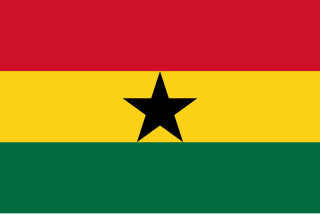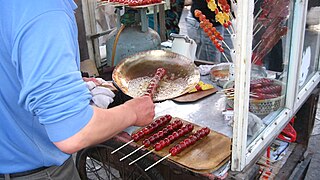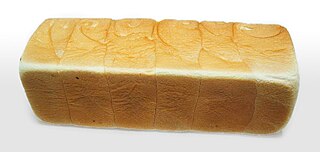
Cornbread is a quick bread made with cornmeal, associated with the cuisine of the Southern United States, with origins in Native American cuisine. It is an example of batter bread. Dumplings and pancakes made with finely ground cornmeal are staple foods of the Hopi people in Arizona. The Hidatsa people of the Upper Midwest call baked cornbread naktsi, while the Choctaw people of the Southeast call it bvnaha. The Cherokee and Seneca tribes enrich the basic batter, adding chestnuts, sunflower seeds, apples, or berries, and sometimes combine it with beans or potatoes. Modern versions of cornbread are usually leavened by baking powder.

Boxty is a traditional Irish potato pancake. The dish is mostly associated with the north midlands, north Connacht and southern Ulster, in particular the counties of Leitrim, Mayo, Sligo, Fermanagh, Longford, and Cavan. There are many recipes but all contain finely grated, raw potatoes and all are served fried.

Ghanaian cuisine refers to the meals of the Ghanaian people. The main dishes of Ghana are centered around starchy staple foods, accompanied by either a sauce or soup as well as a source of protein. The primary ingredients for the vast majority of soups and stews are tomatoes, hot peppers, and onions. As a result of these main ingredients, most Ghanaian jollof rice, soups, and stews appear red or orange.

Coco bread is a Jamaican bread eaten on the island and in other areas of the Caribbean. The bread contains coconut milk and is soft and slightly sweet in taste. It is made to be split in half, and is often stuffed with a Jamaican patty or other fillings to form a sandwich. It is usually found in school cafeterias and bakeries.

A great variety of cassava-based dishes are consumed in the regions where cassava is cultivated. Manihot esculenta is a woody shrub of the spurge family, Euphorbiaceae, native to South America, from Brazil, Paraguay and parts of the Andes.

Nordic bread culture has existed in Denmark, Finland, Norway, and Sweden from prehistoric times through to the present. It is often characterized by the usage of rye flour, barley flour, a mixture of nuts, seeds, and herbs, and varying densities depending on the region. Often, bread is served as an accompaniment to various recipes and meals. Nordic breads are often seasoned with an assortment of different spices and additives, such as caraway seeds, orange zest, anise, and honey.

Sandwich bread is bread that is prepared specifically to be used for the preparation of sandwiches. Sandwich breads are produced in many varieties, such as white, whole wheat, sourdough, rye, multigrain and others.

Regional street food is street food that has commonalities within a region or culture.

Northern Irish cuisine encompasses the cooking styles, traditions and recipes associated with Northern Ireland. It has distinctive attributes of its own, but has also drawn heavily from Irish and British cuisines.
Bread is a staple food throughout Europe. Throughout the 20th century, there was a huge increase in global production, mainly due to a rise in available, developed land throughout Europe, North America and Africa.

Concha, plural conchas, is a traditional Hispanic sweet bread with similar consistency to a brioche. Conchas get their name from their round shape and their striped, seashell-like appearance. A concha consists of two parts, a sweetened bread roll, and a crunchy topping. The most common crunchy topping flavors being chocolate, vanilla, and strawberry. Conchas are commonly found throughout Mexico and Guatemala in panaderias. They can now also be found in grocery stores and bakeries across the United States.

Bread has a significance beyond mere nutrition in many cultures in the Western world and Asia because of its history and contemporary importance. Bread is also significant in Christianity as one of the elements of the Eucharist; see sacramental bread. The word companion comes from Latin com- "with" + panis "bread".

Festival or Jamaican festival is a type of deep-fried bread, typical of Jamaican cuisine, Despite its slightly sweet taste, it is served as a side dish with escovitch fish, seafood or jerk chicken, as well as, a breakfast item and street food.
Breakfast, the first meal of the day eaten after waking from the night's sleep, varies in composition and tradition across the world.

Japanese milk bread, also called Hokkaido milk bread, or simply milk bread in English sources, is a soft white bread commonly sold in Asian bakeries, particularly Japanese ones. Although bread is not a traditional Japanese food, it was introduced widely after World War II, and the style became a popular food item.














